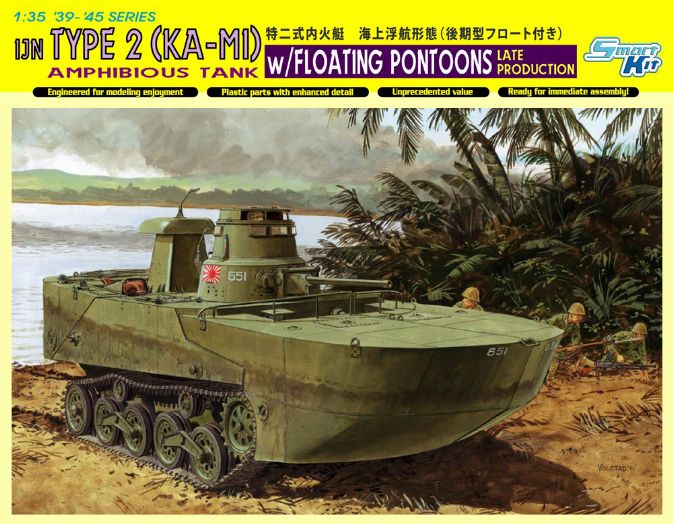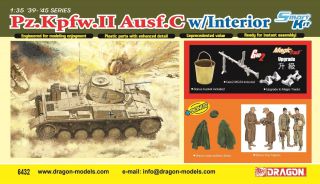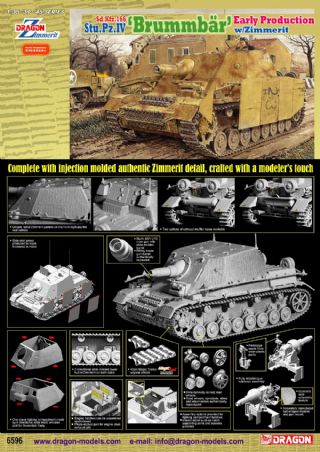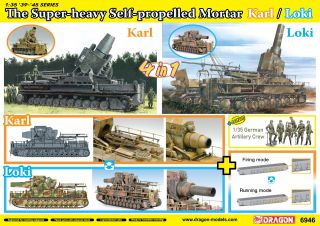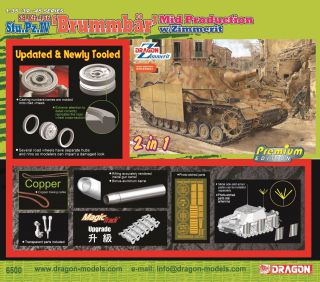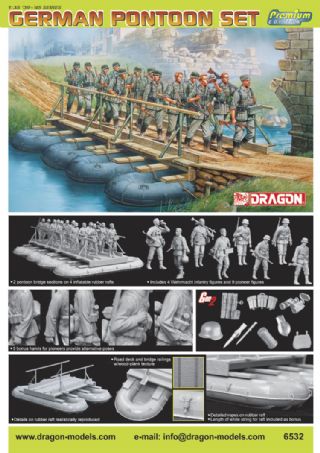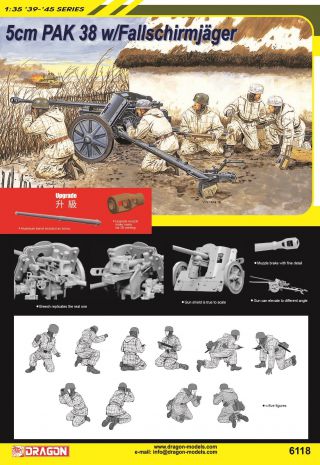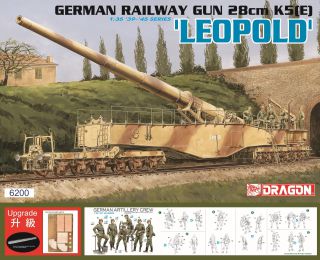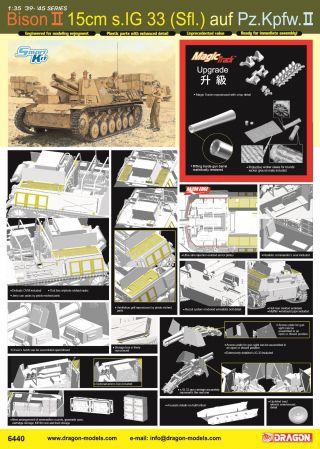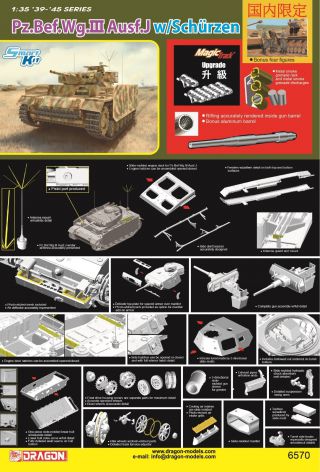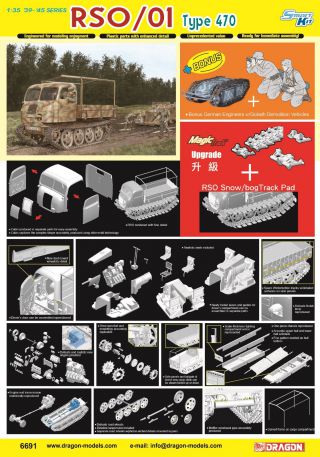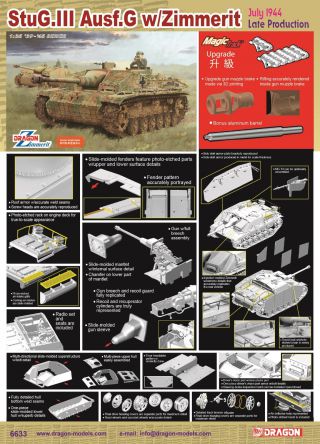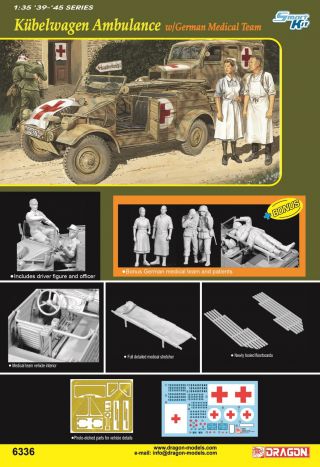HOME → Dragon Plastic Model Kits → 1/35 WWII Military → 6712
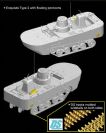

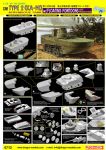
Feature List:
- Exquisite Type 2 with floating pontoons
- DS tracks molded w/details on both sides
- Kuril Island Type
- Slide-molded hydroscope w/transparent-plastic parts molded on turret
- Delicate engine deck vent included
- US- captured type
- Leyte Ormoc Type
- Newly produced pontoon represented by multiple parts can be assembled in 3 optional types
- Rail on front pontoon included
- Slide-molded rear pontoon produced
- Rubber seals on bottom of pontoon have option of either plastic-injection or photo-etched
- One-piece upper hull made by slide mold
- One-piece lower hull made from 3-directionial slide mold
- Accurately detailed idler adjustment mountings
- Detailed track tension adjuster
- Delicate road wheels w/authentic separate parts
- Suspension mount produced
- Different bolt heads molded on left-side and right-side road wheels
- Realistic return rollers included
- Detailed idler wheels
- Sprocket wheels w/breathtaking detail and multiple delicate parts
- Photo-etched exhaust cover realistically produced
- Multi-piece exhaust pipe and muffler offer easy assembly and maximum details
- True-to-scale ultra-thin propellers
- Slide-molded rudder mechanism on rear pontoon
- Ventilation grill hatch can be assembled open/closed
- Hatches on upper hull and driver's port can be assembled open/closed
- Intricate Type I 37mm gun and Type 97 light machine gun included
- Transmission access hatches can be assembled open/closed
Dragon’s first ever 1/35 scale Smart Kit of the Japanese Type 2 “Ka-Mi” amphibious tank (Item No.6678) proved a blockbuster! Now comes another version with even more goodies, a Type 2 complete with a set of floating pontoons. The “Ka-Mi” was the first amphibious tank used by the Imperial Japanese Navy (IJN). It was designed for Japanese landing forces performing amphibious invasions of Pacific islands that didn’t have regular port facilities. Production commenced in 1942 and a total of 184 Type 2 tanks were built. When used in water, two large pontoons were attached to the glacis plate and rear deck to give it a top waterborne speed of 10km/h. These pontoons could be shed as soon as it reached land.
This 1/35 scale kit is obviously based on the company’s earlier release, but the bonus this time around is the floating pontoons. The front pontoon is composed of two halves (Late Production) that are brand new toolings. Other parts such as the conning tower, rudder and hydroscope suitable for its amphibious role are also fully detailed. There’s widespread use of slide molds to enable crisp detail. The one-piece upper-hull and lower-hull components, for example, are both slide molded. It also features highly detailed and easy-to-assemble DS tracks. This creates many possibilities for dioramas and modelers. This Type 2 with pontoons is thus a unique item from the Pacific theater of war, making this kit invaluable for model-makers.
Review:
Kit Review: Dragon Models Limited 1/35 scale ‘39-‘45 Series Kit No. 6712;
IJNavy Type 2 (Ka-Mi) Amphibious Tank w/Floating Pontoon Late Production -
Smart Kit; 367 parts (320 in grey styrene, 31 etched brass, 13 clear styrene,
2 DS plastic track runs, 1 length of copper wire); pre-order price US$62.95
via Dragon USA Online
Advantages: adds the flotation pontoon to the excellent kit; pre-molded open
hatches makes installation of a full interior a snap; wise inclusion of DS Plastic
track avoids frustration with itty-bitty single links; nearly identical to more
expensive cyber-hobby.com kit
Disadvantages: nothing major noted
Rating: Highly Recommended
Recommendation: for all Pacific War modelers and diorama fans
As I noted when the first (non-amphibious) version of this kit was released,
amphibious tanks per se are a contradiction in terms, for as the old farmer
in the joke knows, “cast iron sinks” and so does steel. Items which were created
to stop bullets, shell splinters and projectiles from penetrating them also
did not need to be 100% watertight to do that job well.
During the 1930s only two nations gave serious thought to amphibious light tanks
for scouting purposes: the USSR and Japan. The former did it as an analysis
of the terrain of the country said they would encounter a water obstacle which
could not easily be forded every 10 kilometers and a river every 50. The latter
did it for, as an island nation, they knew they would need to move from island
to island if they wanted to defend their empire or expand it.
In order to have true sea-keeping qualities, the vehicle must have a sufficient
buoyancy reserve or it will quickly be swamped even in a mild sea state (think
of the DD tanks at D-Day). The Japanese approach was to make a larger, roomier
hull but add large and bulky pontoons at the bow and stern. Essentially the
Type 2 was a seagoing derivative of the land-locked Type 95 Ha-Go but with more
than enough sea-going buoyancy. The Type 2 Ka-Mi (a 1942 design) was the most
prolific amphibious tank with about 185 of them being built during the war.
It did mount a 37mm cannon and two 7.7mm machine guns, one of which could only
be used when the bow pontoon was dropped. The vehicle weighed 13 tons with the
pontoons mounted, and 10 when they were dropped. It was followed by the much
larger and heavier Type 3 “Ka-Chi” and Type 5 “To-Ku” amphibious tanks with
47mm guns, but neither one of them was much of an improvement.
Using mechanical components from the land-based Type 95, the Type 2 used a new
hull design with pontoons held in place with “claw” type clamps that could be
jettisoned from inside the tank when the vehicle no longer needed them. Divided
into separate compartments, the pontoons gave excellent buoyancy at sea and
proved to be effective. But like all amphibious tanks designed to be amphibious
first, it was thinly armored and quite vulnerable to mines. Few actions were
carried out by Type 2 tanks with their amphibious qualities put to the test,
and most were forced to fight on land which was not their strong suit. As a
result, they were encountered by US forces starting in 1943 but quickly eliminated.
One example captured by the Soviets (with its pontoons!) exists today in the
Kubinka Museum in Russia and several others are still found where knocked out
on Pacific islands.
This kit is noted as a “late production”model but from what I can tell is essentially
the cyber-hobby.com version of the kit with a few minor tweaks and using different
parts previously molded on the sprues. It has a total of 110 more parts than
the non-amphibious version and shaves US$12 off the price of that kit.
The kit builds on the DML release, which came with a minimal interior but all
hatches separate for posing positions. Some interior is included, such as the
three-piece “claw” connectors and handwheels, what appear to be two either fuel
or ballast tanks, and the machine guns and the 37mm gun with mounting. The new
variant concentrates mostly on the exterior of the vehicle with all of the “Rube
Goldberg” (or “Heath Robinson”) gizmos and devices needed to hold the entire
assembly together.
Assembly mirrors the earlier kit through step 7. Initial assembly begins with
making sub-assemblies of the wheel bogies, idlers, clamps, muffler, main engine
hatches, and interior tanks. These are installed in Steps 2 and 3, which also
cover the assembly of the upper glacis and bow machine gun. Step 4 covers the
assembly of the engine deck (which is cemented in place as the kit comes with
no engine!) and upper hull details. Step 6 covers cementing the upper and lower
hulls together and initial assembly of the 37mm gun.
The gun is a typically over-engineered Japanese weapon of the time and the kit
requires 15 parts for it and its coaxial machine gun to form a single unit.
As this gun is only about 50mm long on the kit, that’s a lot of parts for a
very small gun.
Step 7 is when you begin to work on the pontoons. This kit offers three different
ways to assemble them: Leyte Ormoc style, Kuril Island style, or one captured
by the US. These are complex affairs and the mold makers have attempted to get
it right, but there is a seam between the left and right halves of the bow pontoon
(parts L1 and L2). The directions are very confusing here, as the attachment
devices (either parts M8/M9 or B19) are for “disconnecting”. One is the open
claw (B-19) and M8/9 are closed ones, so apparently you use M8/9 when the pontoons
are mounted and B19 if they are not. You also mount the engine radiator intake
trunk (parts J12-14-18/19) in this step.
Steps 8-11 cover the turret and its details, which are many and pretty clunky
in design (not DML’s fault – speak to the original managers on that one...)
The turret comes with a ring and drive as well as optional choices for the viewers
and periscopes. Also a choice of what appears to be an AAMG mount on the rear
of the turret is offered. However, in step 13 you also install the conning tower
which consists of four parts plus six clear styrene view blocks. It also requires
the copper wire be installed to the rudder control and rudder yoke at this time.
Lastly are the tracks but as they are DS plastic and identical not a problem
in sorting. As with most tracks, DML shows them being installed “V” shape down
when looking at them head on. While DS tracks tend to “run large” as most Japanese
light tanks are usually seen with loose fitting track this may not be a problem,
moreso if used in a diorama and “burned out”.
Technical work is credited to Hirohisa Takada with drawings by Shin Okada.
Four marking options are provided, with all vehicles shown in an IJN olive green;
it must be noted that the proper suggested color matches are NOWHERE to be found
in the directions!
The choices are: vehicles 651/652, Ormoc, Leyte 1944 (white numbers, Japanese
battle flags); vehicle 501, Kuril Islands, 1944 (white numbers); vehicle 179,
Unidentified Unit, 1944 (white numbers); Unidentified Unit, 1945 (Japanese battle
flags only). Decals are a targeted set from Cartograph.
Overall while I profess I cannot find any major differences from the earlier
cyber-hobby.com kit this is a wide release at a lower price, which should be
appreciated.
Thanks to Freddie Leung for the review sample.
-Cookie Sewell-

